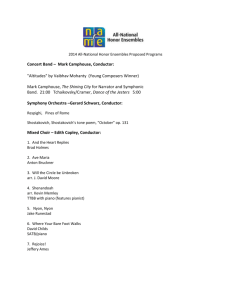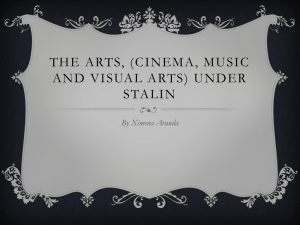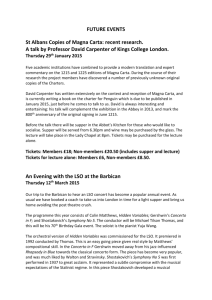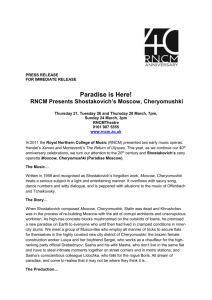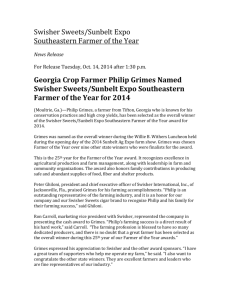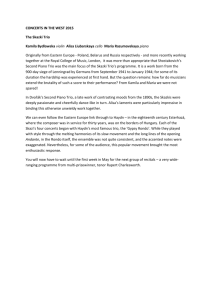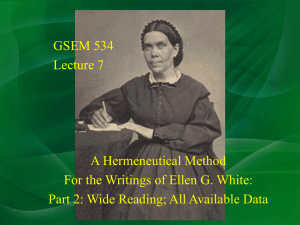Notes for Part 2: Twentieth-century Music
advertisement
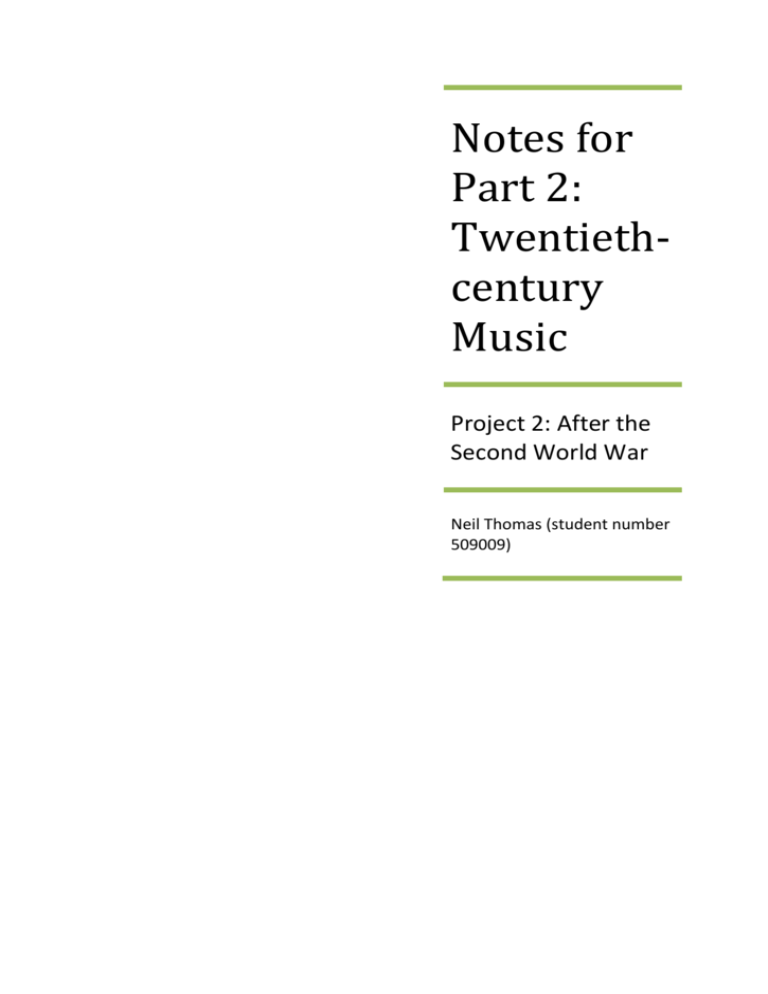
Notes for Part 2: Twentiethcentury Music Project 2: After the Second World War Neil Thomas (student number 509009) Notes for Part Two: Twentieth Century Music. Project Two: After World War Two by Neil Thomas (student number 509009) Electronic Music There were innovations before the war and new instruments emerged such as the theremin (1920), ondes Martenot (1928) and Hammond organ (1929). The tape recorder was also invented in 1935. It was after the war, though that music really began to use modern technology. An important development was the creation of musique concrete by Pierre Schaeffer (19101995) which created music from everyday sounds. In the 1950’s electronic studios began to emerge around the world and the development of the synthesiser made electronic music available to a wider band of musicians. Further developments were the combination of traditional music with taped music which over the years has progressed to the point where a lap top computer can in effect become a musical instrument in it’s own right. The work of Karlheinz Stockhausen (1928-2007) was very important in the development of electronic music and his work has influenced a wide array of musicians from a diverse area. Edwin Roxburgh – At the Still Point of the Turning World (1976) Oboe part then fed and repeated through speakers. Would sound very different without the electronics part. Largely atonal. Other sounds as work progresses, clapping. Filtering? Ring modulation? Increase in dynamics, as different timed tapes come into the piece, joining canonically. Small trills on oboe part produced by flutter tongue technique. Indeterminacy John Cage (1912-92) developed indeterminacy as a reaction to some of the complicated forms of composition being used in Europe such as integral serialism. Cages idea is that composed music could be affected by external factors, not in the control of the composer. Cage had studied with Schoenberg and was also influenced by eastern philosophies. His early works used serialism combined with rhythmic attributes of eastern music. Cage’s best known work 4’33”, is for any number of musicians, and they don’t play a note. It is a study in the sounds around the arena, audience sounds, coughs, rustling of programmes etc. John Cage – 4’33” My own performance. Wind blowing, cars, one with trailer, fan from convector, dull burr from freezer, a distant aeroplane. Wind blowing on venetian blinds. Exercise: Considering chance and serial music John Cage – Imaginary Landscape No 5 Early fragments of jazz exerts mixed up. John Cage – Sonatas and Interludes for Prepared Piano, Sonata II Notes played in an unorganized manner, atonal work. Different sounds 2 Notes for Part Two: Twentieth Century Music. Project Two: After World War Two by Neil Thomas (student number 509009) John Cage – First Construction in Metal Mainly percussive opening. Again quite unorganised and random. More of a rhythm and structure to this work that in the first two works. Various, mainly metallic devises used to create sound. Alban Berg – Violin Concerto (1935) Tonal work. First movement (Andante-allegro). Does have form, unlike the chance music if indeterminacy. Tonal but with dissonance. Heavy start to second movement (Allegroadagio). Would definitely fit description of music. Tension through dynamics. Beautiful adagio part of second movement to complete work. Extended Tonality – Benjamin Britten Peter Grimes (1945) Benjamin Britten 1913-1976 http://www.oxfordmusiconline.com/subscriber/article/grove/music/O008087 - accessed 25/2/12. Article by Arnold Whittall. The consists of a prologue and three acts and is based on a poem, The Borough by George Crabbe, with a libretto by Montagu Slater. First performed at Sadler’s Wells, London, June 7th 1945. Set in a south east England coastal town called the Borough in about 1830. Britten came across Crabbe’s work whilst in California with Peter Pears in 1941 (pears had a book of his works) and the two worked on a sketch whilst in California and by the time they returned to Britain in March 1942 had worked out the opera as it would be and transformed the character of the title from the nasty person that Crabbe envisaged to the misunderstood character in the opera. Montagu Slater agreed to write a libretto after Christopher Isherwood had turned it down and the draft of this was completed by the end of 1942. Britten set about composing the music sometime in 1944 and the work was completed by February 1945, but not in the form it would eventually appear. Stage director Eric Crozier and leading tenor Peter Pears had decided early on that Peter Grimes would be used to reopen Saddler Wells following the end of the war in Europe. Reginald Goodall conducted the première, with Peter Pears as Grimes and Joan Cross as Ellen Orford. Peter Grimes quickly established itself in the operatic repertoire as one of the most successful twentieth century operas and Peter Pears became the establish tenor in the lead role. Britten conducted a recording with Peter Pears in 1959. It was televised by the BBC in 1969. The prologue takes place at a coroner’s inquest, where the fisherman, Peter Grimes is cleared of blame in the death of his apprentice who was died in a fishing accident. The mood of the people is against Grimes. Ellen Orford shows sympathy in Grimes, who is told not to apprentice any more young boys. Britten uses conflicting keys, B flat and A in a duet between Grimes and Orford. 3 Notes for Part Two: Twentieth Century Music. Project Two: After World War Two by Neil Thomas (student number 509009) The first of the four sea interludes precedes Act one, which open with a chorus of the towns folk going about the early morning activities of a busy fishing town. Act One develops with a series of linked events as the ment of the town are reluctant to help Grimes but Ellen Orford again defends him. Grimes then expresses his anguish of the events that lead to the death of his apprentice, vowing that he will win over the borough. The second interlude, a quite spectacular depiction of a storm links act 1, scene 1 to scene 2. Britten keeps the tension throughout the act as the scene moves to the pub, The Boar Inn, as the storm rages outside various roles, some sung, some recitative join before Peter Grimes bursts in to collect his new apprentice. The apprentice is eventually bought to the pub by Ellen and Hobson and Grimes without greeting takes the boy away as Ellen sing ‘Peter will take you home’, a refrain repeated by the chorus in an ironic manner. The third interlude projects the image of a bright Sunday morning, here Britten uses string and woodwind with horns and trumpets coming in on the final motif before the action of act two commences. Act Two’s opening scene is on a street near the sea on a fine sunny day. Ellen is knitting with Grimes new apprentice, but she then notices a tear in the boy’s coat and a bruise on his neck and she becomes agitated. Grimes then turns up to take the apprentice away, as he believes only hard work earns the respect of society. Ellen and Grimes argue and Grimes strikes Ellen before departing with John (his apprentice). The borough then assembles around the distraught Ellen, who still defensive of Grimes explains with motives, but now without sympathy. Lead by Boles, the people seek retribution and Britten uses grim music to express the rage of the people of the borough as the men march off to Grimes hut to save the apprentice. The four women are left behind to reflect what has happened. Britten brings the mood of each part to this final part of the scene, i.e. the happy Ellen at the start, the determination of Grimes, the anger of the crown and the reflections of the women. Dissonance plays a part in the way Britten structures this part. As the scene shifts to Grimes hut, an upturned boat on a cliff top, the fourth interlude, a passacaglia developed from ‘Grimes is at exercise’ links the scenes. The opening of scene II encapsulates Peter Grimes inner turmoil, he feeling of both violence and tenderness to he new apprentice, his remorse of the death of his first apprentice and his feeling towards Ellen, whom he sees as a possible companion who would give him the stability he seeks, but also the impossibility of this happening. The music of the reflective dreamlike Grimes is ended by the march of the men from the Borough. In his haste to escape the mob, Grimes ushers the boy from his hut, but he falls over the cliff, in an accident (Britten is explicit about this in the score). The rector and Swallow think all is well on finding the hut neat and tidy, but empty, but Balstrode, looking down the cliff see’s the dead boy. Act two ends with the viola motif that opened the passacaglia. Scene one of Act 3 opens on a street by the sea a few day’s later. The orchestral opening is a scene setting the mood of the night, whilst dances are heard from the Moot Hall. The landlady is speculation that Grimes has murdered the boy. The scene is of mild conversation, as the rector flirts with the nieces, but Balstrode and Ellen are overheard discussing the fact that Grimes’ boat has returned, but there is no sign of Grimes himself. Balstrode has found 4 Notes for Part Two: Twentieth Century Music. Project Two: After World War Two by Neil Thomas (student number 509009) the boys shirts and Ellen laments that she recalls sowing the anchor on the shire. Mrs Sedley who overheard Balstrode and Ellen talking rouses the townsfolk that Grimes is back. Balstrode and Ellen talk of helping Grimes, although they now know he cannot be saved. The final part of Act 3, Scene 1 uses a ferocious passage of music as the town is roused by Mrs Sedley repeating what she has overheard and the people plotting vengeance on Grimes. Act 3, Scene 2 – the final orchestral interlude has the effect of changing the mood, not the scene, which remains in the street by the coast. The music of the final scene changes at different point, to reflect the poor mental health of Grimes. There are also reprises of earlier material. When Ellen and Balstrode appear, Ellen wants to take Grimes home but Balstrode urges his to take his own life, Flute motif at end as orchestra rejoins with the ‘dawn’ music from earlier in the opera and members of the cast talk of a sinking boat no longer visible at sea. This is a refrain of indifference from the Borough. A tragedy has occurred but life seems to go one, despite the fact that it shouldn’t. Holden, Amanda (1995), The Penguin Opera Guide, Penguin Books, London. Pp 54-57: The première of Peter Grimes was seen as a watershed for British music and although there was opposition at Saddler’s Wells, the work was a success with public and critics, Britten would become the first British born composer, who’s primary field was opera in over 300 years. Within three years the major opera house of Europe had produced the opera, including under the baton of Tullio Serafin in Milan. Leonard Bernstein would conduct it’s American première. Peter Grimes was commissioned whilst Britten and Pears were in America by the Koussevitzky Music Foundation. The foundation commissioned a full length opera, following the success of Paul Bunyan in America and Britten and Pears sketched Peter Grimes. Eric Crozier re-wrote some of the libretto during the first production. 5 Notes for Part Two: Twentieth Century Music. Project Two: After World War Two by Neil Thomas (student number 509009) Shostakovich and Politics Dmitri Shostakovich (1906-75) Shostakovich was a very productive composer during the Soviet period, but under Stalin’s regime his work came under severe scrutiny in the Communist party’s desire for music of ‘socialist realism’. He was twice rebuked and his works were occasionally banned. Following the opera Lady Macbeth of Mtsenk, Shostakovich was accused of formalism and this work was banned in the Soviet Union. His fourth symphony, being composed at this time was shelved and not performed until 1961 (1962 abroad – Edinburgh). Shostakovich composed his fifth symphony in 1937 and it was described as ‘A Soviet Artist’s Response to Just Criticism’. The final movement draws on Soviet folklore melodies, so meeting the criteria of ‘socialist realism’. The symphony though has been interpreted as being a parody of socialist realism. The tempo marking of the final movement are a matter of dispute and have been performed at both the official quaver = 184 and the suggested crotchet = 184. The slow official tempo may have been a deliberate act to rebel against the authorities in what should have been a quick tempo finale. Shostakovich – Symphony no 5 fourth movement, Version one: Mstislav Rostropovich (quaver = 184)(12:04) Opens with percussion. Heroic. Woodwind. Strings. Brass. Castanet, percussion, folk style. Lot of dramatic parts. Slower at 3:41.Ostinato rhythm, slow. Repeated A in unison. Slow middle section leads to rise in dynamics, although not a great deal of change to tempo. Ends with timpani as it began. David Fanning and Laurel Fay. "Shostakovich, Dmitry." Grove Music Online. Oxford Music Online. 3 Mar. 2012 <http://www.oxfordmusiconline.com/subscriber/article/grove/music/52560pg1>. Shostakovich was a member of the ‘circle of young composers’ (1921-24) who were a group of young Soviet musicians who had an interest in contemporary developments in the west. As a student Shostakovich did not rebel against his teachers as Prokofiev had and so had a good grounding in both traditional and contemporary form. Shostakovich’s correspondence with an early love, Tat’yana Glivenko, is revealing of his political feelings as a young man. He was generally in agreement with communism but had reservations about some of the inherent impracticalities. In 1925 Shostakovich met the music lover Mikhail Tukhachevsky, who introduced him to the composer and theorist Nikolay Zhilyayev, who in turn became a mentor to the young composer. Both Tukhachevsky(1938) and Zhilyayev (1937) were arrested and executed in the Stalin’s Red Army purge. Another victim of the purges was Mikhail Kvadri, who in 1925 was the dedicee of his first symphony. He was a student friend of Shostakovich and the first acquaintance to be a victim of the purge in 1929. The first performance in May 1925 of the symphony was a great public success but critical acclaim was good but reserved. It did however get international acclaim and became the first Soviet work to get a place in the Western repertoire. 6 Notes for Part Two: Twentieth Century Music. Project Two: After World War Two by Neil Thomas (student number 509009) Shostakovich was permitted to travel abroad during the 1920’s, visited Warsaw for a piano competition and visited Berlin on the return journey. Also met Prokofiev on one of his trips to Russia in 1927. In 1927 Shostakovich was commissioned by the Propaganda Department to write Symphonic Dedication to October, to mark the 10th anniversary of the October revolution. This became his second symphony and included factory hooters and a text that was a propaganda statement that Shostakovich privately did not like. He also wrote Lady Macbeth of Mtsensk during the same year. In 1930 Shostakovich’s first opera, The Nose had it’s première and in marked a change in critical attitudes, as for the first time Shostakovich was accused of formalism. Up to this point arts had enjoyed pluralism in Soviet Union, but things were now changing. By 1929 the Russian Association of Proletarian Musicians (RAMP) had gained acceptance over the western influenced Association of Contemporary Musicians. This was to change in 1932. RAMP who’s ascendency as an independent body had been rapid was replaced by The Union of Soviet Composers. The initial response to this organization was good from Shostakovich and other composers as it gave a basis for music education and infrastructure within the Soviet Union. However it was soon to become a tool for state control over music. The remit of this new organization was socialist realism in music, which at the time was defined as: ‘the truthful and historically concrete representation of reality in it’s revolutionary development’. Whilst Shostakovich spoke out in favour of much of official part opinion, he criticized jazz for instance, he also practised these other disciplines including jazz, e.g his first jazz suite (1934). During the purge, Shostakovich wrote film scores, ballets and theatre works which were largely propagandist. This was an embarrassment to Shostakovich, who did not entirely believe in the ideology of Stalinist doctrines. These works were lucrative for Shostakovich, but the thin plots largely portraying heroic socialist figures against the capitalist bourgeois figures were not to his liking. Shostakovich found it easier to write satirical music than positive music, with the result that the music representing the villains (ie the capitalists) was better to listen to than the music written for the socialist heroic character being portrayed in a positive way. Shostakovich worked on his first ballet scores in 1929-31 and these too had a propagandist theme which were not to his liking and he determined to work on projects that were of interest to him. He did enjoy working with some talented theatre directors and with TRAM (Leningrad Theatre of Young Workers) until it was clear that this organization was also motivated by Soviet political policy. By late 1931 Shostakovich had decided that his only works worthy of contributing to Soviet arts were his third symphony and The Nose, and was concerned at the dire state of Soviet music in general. He decided to take a 5 year hiatus from theatre work and was involved from the start in the foundation of the Union of Soviet Composers and served on the governing body of the Leningrad branch. The Nose was the first Shostakovich opera and did not feature an ideological theme. In 193132 he began work on Lady Macbeth of the Mtsensk District and was confident of it’s success. 7 Notes for Part Two: Twentieth Century Music. Project Two: After World War Two by Neil Thomas (student number 509009) The première of Lady Macbeth in 1934 was a massive public and critical success and was performed 177 times in its first couple of years, usually to packed houses. Shostakovich planned a teratology of opera’s based on Russian heroines. The only criticism of Lady Macbeth was from the conservative wing of the composers union. The Stalin purges of ‘The Great Terror’ began from December 1934 and every Soviet artist was at risk of arrest or worse. Stalin and some cronies attended a performance of Lady Macbeth and the ballet The Limpid Stream which were both widely condemned, initially anonymously in Pravda and then in general by music critics and members of the union of composers. This took away Shostakovich’s pre-eminence as the Soviet Union’s leading composer which he would eventually regain but always in fear of the authorities. Some of the people that criticised Shostakovich, such as Asaf’yev, never regained the respect of Shostakovich and there were some exception who defended his work. But in the context of the purges these critics had little choice but to toe the party line because the recriminations if you did not were so terrible. Virtually every family in Moscow and Leningrad, including Shostakovich’s were affected by the purges. Shostakovich asked his friend Isaak Glikman to keep a scrapbook of the negative reports he was receiving and asked Tukhachevsky to intervene. There are reports that during this period Shostakovich contemplated suicide. Tukhachevsky would perish in the purges and it is also reported that Shostakovich was interrogated about his relationship with the Marshall. The NKVD allegedly listed Shostakovich as a Trotskyite. Shostakovich was kept going by the birth of his first child and the work on his fourth symphony which was completed in May 1936. Under official pressure it was withdrawn shortly before its première. It was released as a work for two pianos in 1946 and the symphony was not finally premièred until 1961, during Shostakovich’s final rehabilitation. Photograph: Cite: "Shostakovich (centre) with Prokofiev (left) and Khachaturian, Moscow, 1945." Grove Music Online.Oxford Music Online. 4 Mar. 2012<http://www.oxfordmusiconline.com/subscriber/article/img/grove/music/F006162>. In December 1936 Shostakovich wrote a Curriculum Vitae in La Revue Musicale in which he commits to ‘the development of socialism in my country’. It makes no mention of the earlier events. Shostakovich now had to satisfy both his artistic urges and the criteria set from above. In December 1936 to celebrate the 100th birthday of Pushkin, Shostakovich wrote music to Pushkin texts. One of these ‘rebirth’ is seen as depicting his personal situation at the time and the opening line of the song reappear in the finale of the fifth symphony. From this point on Shostakovich’s work is often viewed as having hidden meaning, but not in any obvious way where it could endanger his life or freedom. The première of the fifth symphony on November 21st 1937 was an overwhelming success and there was open weeping during the slow movement and a half hour ovation at the end. This is both seen a celebration of the composers rehabilitation and the people expressing themselves about the horror of ‘The Great Terror’ in the only way they could in public. The work was received very well by public and critics, although some did notice the unresolved tensions of the finale (Fanning). In 1937 Shostakovich took a post teaching instrumentation and composition at Leningrad conservatory. He would teach, except between 1948-1961 when he was once again fallen from grace, until 1968. 8 Notes for Part Two: Twentieth Century Music. Project Two: After World War Two by Neil Thomas (student number 509009) A combination of teaching commitments and having now been rehabilitated the fear of not loosing that status meant that Shostakovich worked on few major works during the period of World War 2. Only the sixth symphony of 1939 with contrasting moods is of any significance. He did however work on small works of mainly chamber music. When the Germans invaded Russia, Shostakovich was caught up in the patriotism that Stalin encouraged and started work on the seventh symphony. When he was evacuated from Leningrad he completed the symphony in the East of the country on December 27th. The seventh symphony was premièred at Kuybïshev on March 5th 1942 and the score was transported west via microfilm and against fierce competition Sir Henry Wood gave it its western première at the London Proms. This work was played in Leningrad on the day Hitler said it would fall, by a group of musicians still in the city and others transported there for the occasion. They played it to German troops as an act of defiance. The work came to be a symbol of anti-fascism in the west and a festival of Shostakovich’s music was performed in San Francisco in September 1942 and birthday greetings were sent from Charlie Chaplin, Paul Robeson, Toscanini and Stokowski. The eighth symphony of 1947 by contrast was a dour affair and not welcomed with any enthusiasm. January 1948 saw the beginning of the next clampdown on composers by Andrey Zhdanov, the man put in charge of the arts. Shostakovich wrote a satirical cantata based in part on Zhdanov’s speech, which was mainly notated in 1957, worked on in the 1960’s but not performed until post-glasnost times in 1989 Anti-Semitism became a part of Soviet culture from 1947, although not officially, and Shostakovich had to shelve several works that drew on Jewish folklore. He was criticized by the composers union and spoke out in his defence which lead to his music once again being blacklisted. He was sent on international conferences as part of his rehabilitation where he often had to pretend agreement with the Soviet Union’s restrictive policies. His 10th symphony in 1954 lead to days of debate about its suitability, but following Stalin’s death in 1953 the restrictions on art were slowly lifting. Following Stalin’s death the period under Nikita Khrushchyov became known as ‘the Thaw’ and thing gradually got easier for both the general public and artists. Gradually Shostakovich’s banned works were allowed to be performed and on May 28 1958 the antiformalism decree of 1948 was partially lifted. Contact with western artists also became possible and Shostakovich more frequently travelled abroad. In 1960 on his second trip to England he became friendly with Benjamin Britten. Stravinsky also visited the Soviet Union during this period. Although the stresses under Stalin were being eroded, Khrushchyov’s price was a closer following of the party’s doctrines and so Shostakovich accepted several party posts including the committee of the Glinka centenary in 1957 and secretary the now renamed Union of Composers of the USSR. Shostakovich’s music became more conformist during this period including his 11th & 12th symphonies of 1957 & 1961. These celebrated or commemorated the 1905 ‘bloody Sunday’ massacre and the 1917 revolution. 9 Notes for Part Two: Twentieth Century Music. Project Two: After World War Two by Neil Thomas (student number 509009) Shostakovich was put under pressure to join the communist party and in 1960 he did join, much to his shame. (See also notes on ‘The unknown Shostakovich’ TV programme) Following his death in 1975, contemporary obituaries in both the Soviet and western press painted a picture of a committed communist. It is only later scholarly works that have opened up the question of the ‘real’ Shostakovich. http://en.wikipedia.org/wiki/Symphony_No._5_(Shostakovich) - accessed 4/3/12 First performance Leningrad Philharmonic Orchestra, conducted by Yevgeny Mravinsky in Leningrad on November 21st 1937 Dual meaning of third movement. Rostropovich version revisited: Heroic style opening. Developing into slow march, before tempo drops off, as side drum introduces slow section. Flute part, over unison strings, with bassoon. Unison not ostinato. Dynamics increase towards climax but still unison string with woodwind and brass playing melody, heavy, austere sound, not celebratory, but threatens to become that Leonard Bernstein: Quicker tempo from beginning, giving is more joyous texture, totally changing nature of the finale. Side drum again leading into slower section, but this time played at a much faster tempo. The unison A have a different feel at the faster tempo. Vasily Petrenko – Royal Liverpool Philharmonic (slow tempo): Slightly different use of percussion at the transition to the slow section, cymbal and timpani rather than side drum. Complete stop before building towards climax. Subtle differences from the Rostropovich. Dynamics build with the unison A leading up to climax (from slow section). Leopold Stokowski – LSO Quicker tempo. Higher flute part in opening section. 10
